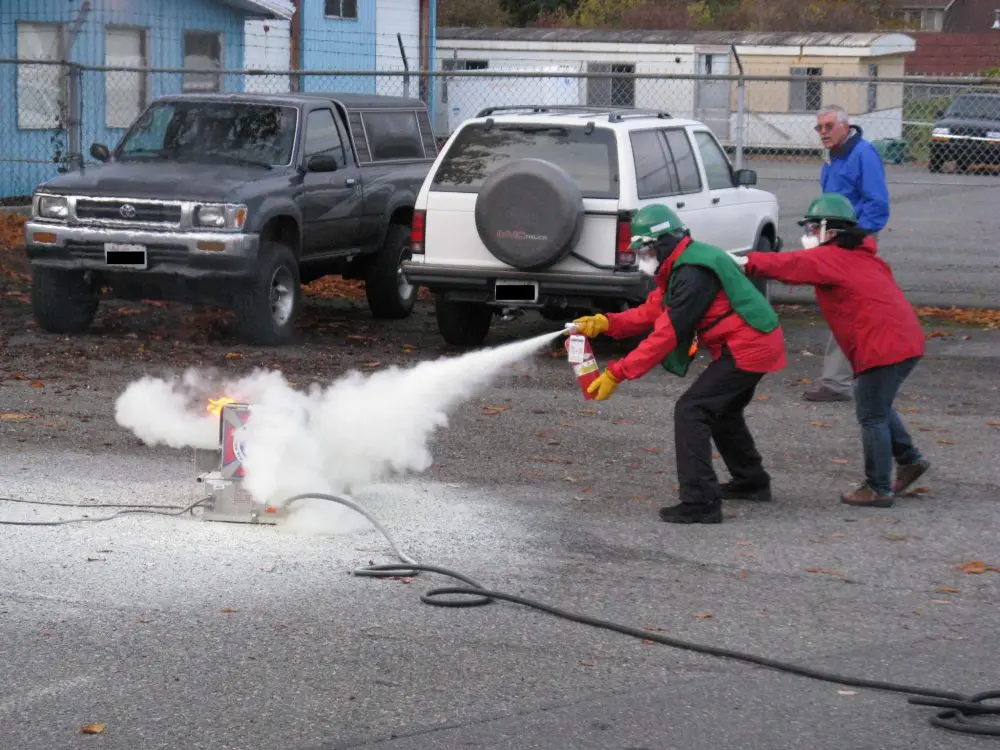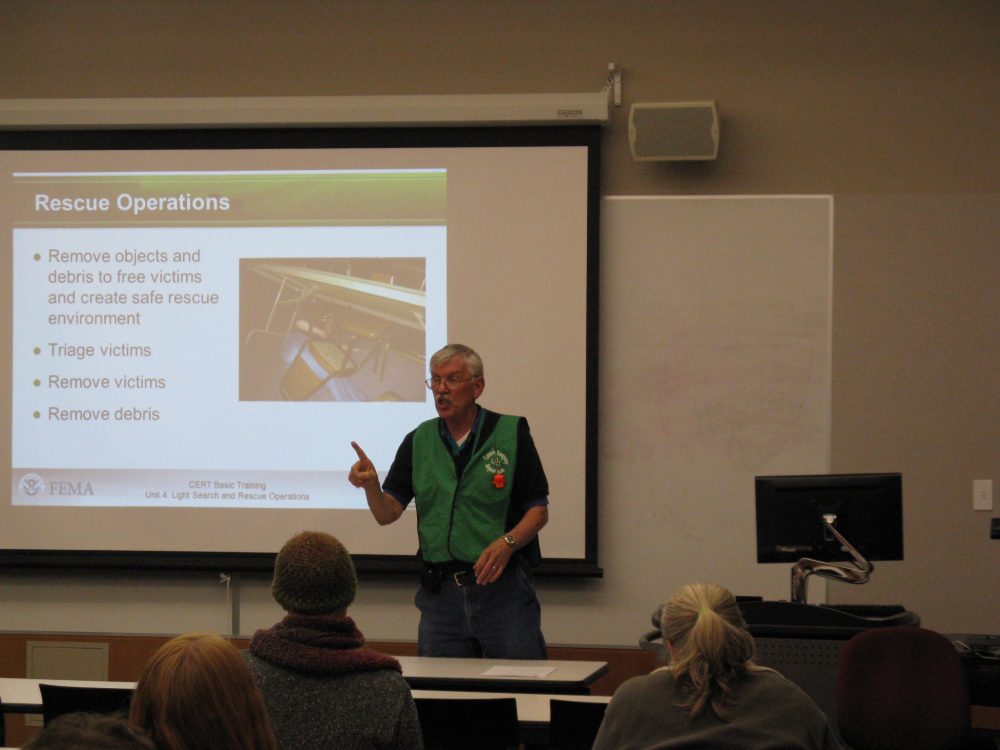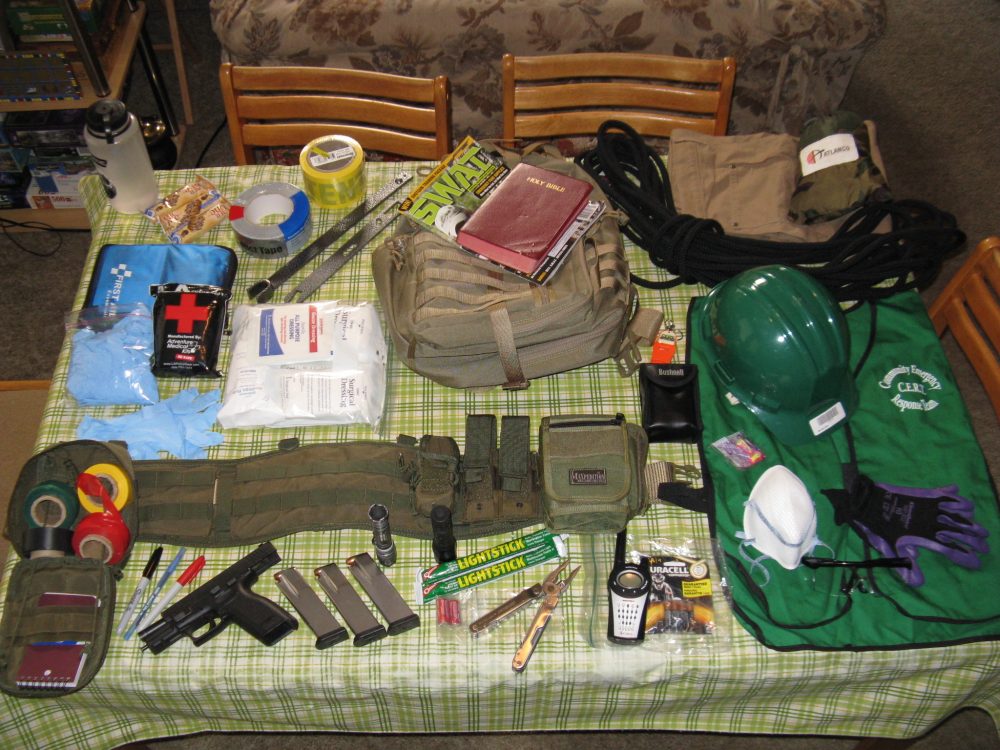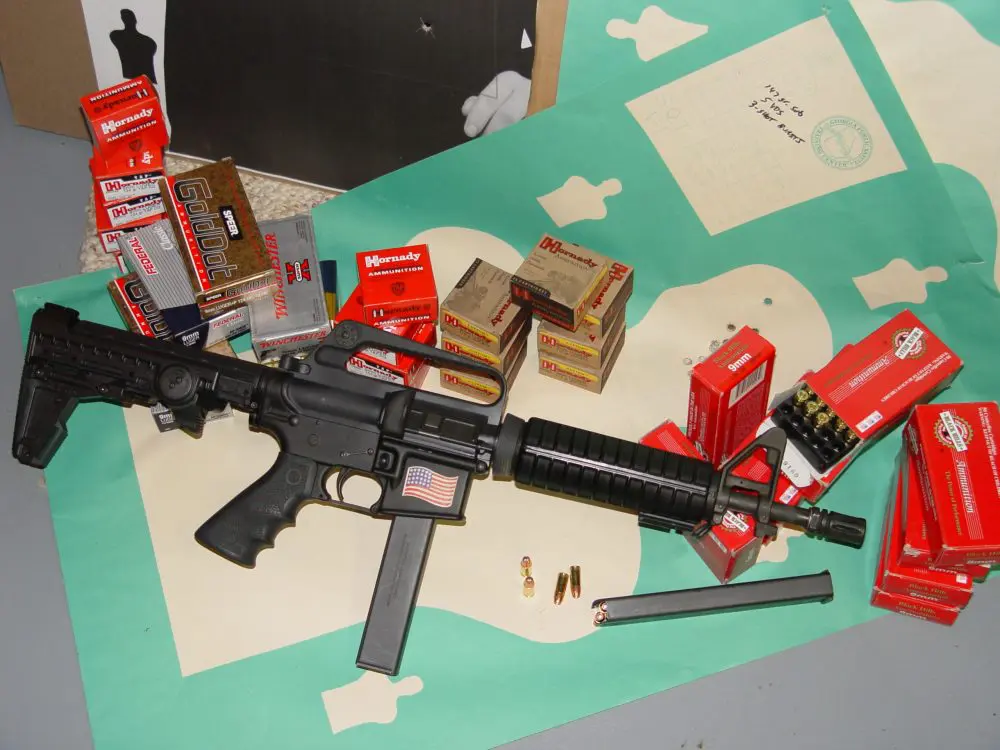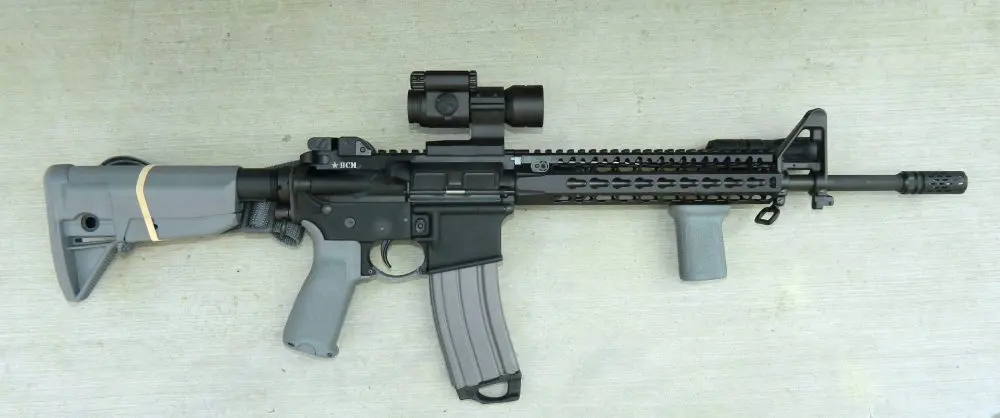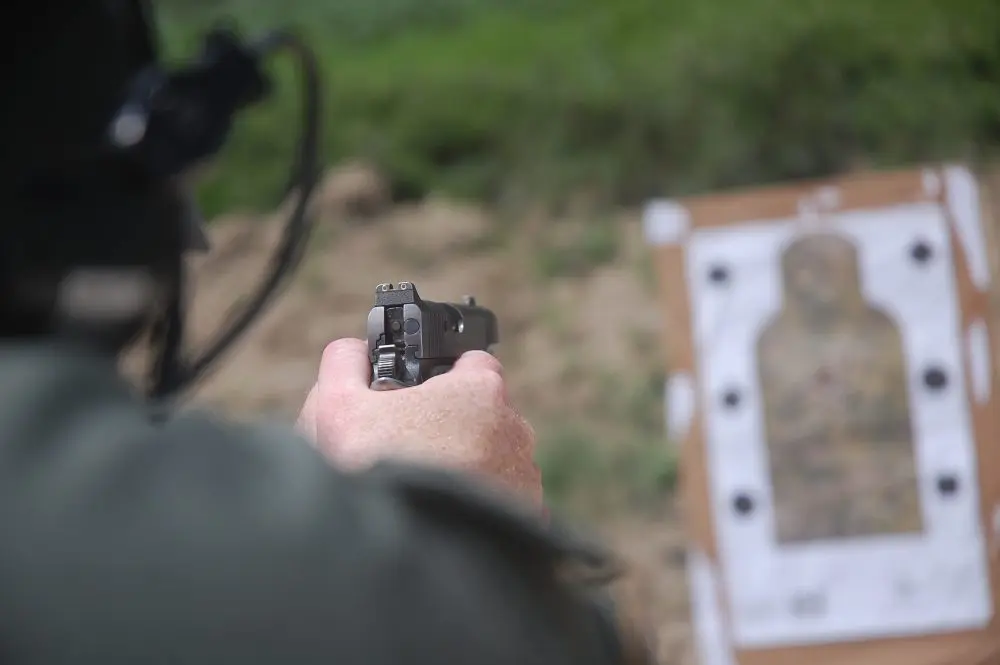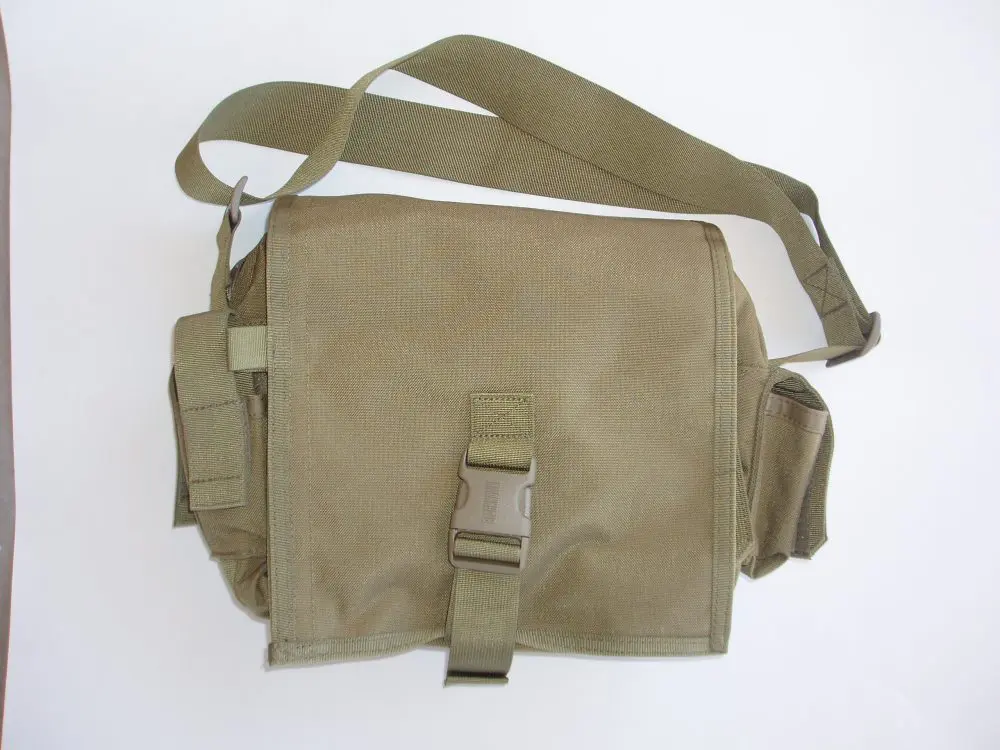After my first firearms training class in 2011, I promised myself I’d save up money to seek additional training every year. That plan almost went out the window when budget, work and personal stuff prevented me from getting in much meaningful trigger time.
Fortunately, I found another opportunity to learn new skills. After participating in an Oral Board for a Whatcom County Reserve Deputy position, the Volunteer Services Coordinator pointed me toward a program I had never heard of.
Each classroom session was guided by a PowerPoint presentation. Instructors fielded questions to ensure that everyone understood the material and nobody was left behind.
Table of Contents
FEMA, CERT, and Other Acronyms
The Community Emergency Response Team (CERT) concept was developed by the Los Angeles Fire Department in 1985, in an effort to provide citizens with basic training for dealing with a catastrophic disaster. These survival and rescue skills would improve the ability of citizens to survive and safely help others until police, fire, or medical services arrive. The training model spread to other fire departments around the country.
In 1994, the Federal Emergency Management Agency (FEMA) expanded on the CERT materials to make the program available nationwide and apply to all hazards. The program has exploded since 9/11/2001, drawing in thousands of citizen trainees across the country.
The real beauty of the CERT program is that, wherever it is available, it is incorporated directly into the Emergency Operations Plan (EOP) of your local county sheriff’s office Division of Emergency Management. CERT members operate alongside police, fire, medical, and public works to deal with emergencies.
When a class popped up with a schedule I could attend, I signed up with my fiancée, Becka. Our course was an eight-week program, three hours on Tuesday evenings at the local technical college.
Fire suppression. CERT rule of thumb: If the fire doesn’t go out after five seconds, you probably can’t put it out on your own. Back out and keep others away.
UNIT 1: PRELIMINARY & DISASTER PREPAREDNESS
Our first day in class covered a ton of information. After introductions, we watched a movie depicting a CERT team in action. Our instructor, Amy Woodfin, walked us through how CERT fits into the county EOP, what CERT members do and don’t do when activated, and the basics of the Incident Command Structure (ICS). We discussed the different types of disasters—natural, technological, and intentional—and how likely they are to hit our community.
The main theme of CERT is “Do the most good for the most people, safely.” During a crisis, CERT members should deal with their own family’s safety before volunteering. The material covered terrorism, even though we were instructed not to get involved. In that case, the rules for CERTs are: secure your family and get to safety.
With the remaining class time, we tore through as much disaster preparedness material as we could. S.W.A.T. readers are probably familiar with these topics: how to pack survival and shelter-in-place kits, what they should include, and where they should be stored.
We didn’t quite get through everything in the time allotted, but we were given our CERT training material (about 200 pages’ worth) and instructed to read through Unit 2 and start packing our kits.
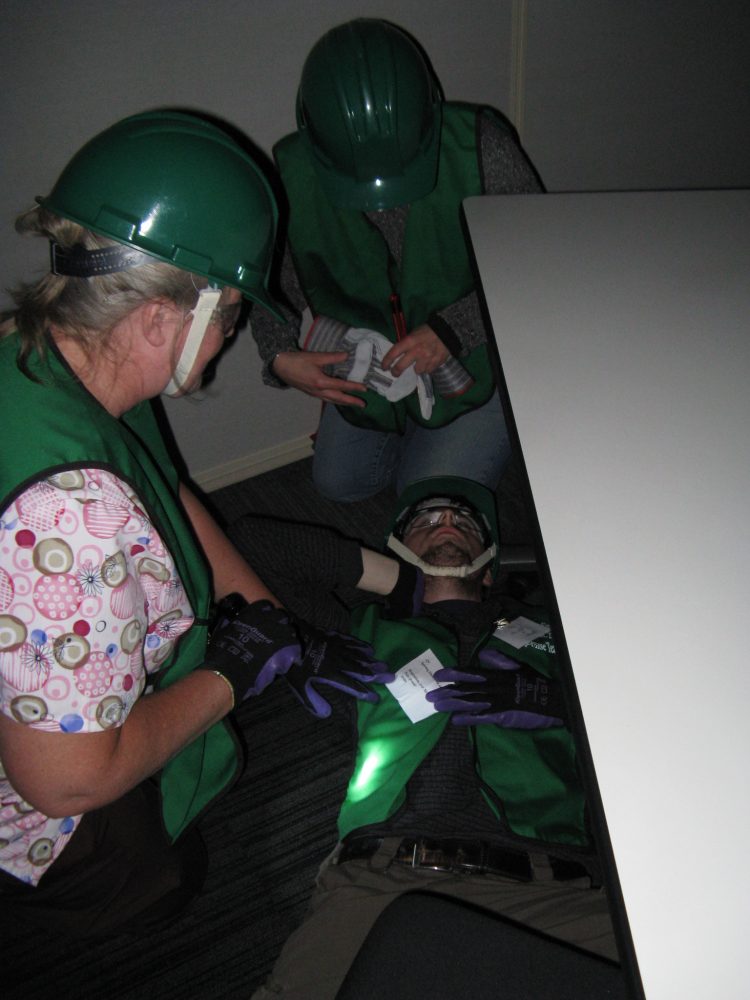
UNIT 2: FIRE SAFETY AND UTILITY CONTROLS
We met at a nearby fire district to practice small fire suppression. We went over the reading material, had a Q&A session, and were issued our basic CERT kits. The kit included nitrile and work gloves, safety glasses, earplugs, emergency whistle, two N-95 dust masks, and a green ANSI rated protective helmet with matching CERT vest.
About the vest and helmet: They may look goofy, but identification is important during a crisis. Since CERT is a recognized part of the county EOP, the “uniform” ensures that any cop, firefighter, paramedic, or public works technician who shows up knows who I am and that I know what I’m doing. I won’t be pestered to show my photo ID or be removed from the scene. Looking official also helps ensure that citizens in the area follow instructions.
We talked about identifying and dealing with utility hazards, such as flooding, gas leaks, and electrical, and went over different types of fire extinguishers, their ratings, and uses for different fires. We took some ABC-type extinguishers outside to practice fire suppression. Unfortunately, due to a communication mishap, nobody told the fire district about the exercise, so we didn’t have a professional on-scene to set up our fires or monitor safety. As a result, our “fire” was a cinder block on the ground. Bummer.
After a post-exercise Q&A, we were sent home to do more reading and begin building our CERT kits up with more necessary equipment.
UNIT 3: DISASTER MEDICAL, PART 1
This was by far my favorite week, with Disaster Triage as the focus. Amy walked us through how to triage a victim in 30 seconds, including identifying and treating the three “killers”: airway obstruction, bleeding, and shock. These are the most important injuries that have to be dealt with immediately before moving the victim to a medical station.
The triage team tags the victim with colored tape based on the severity of the injury, and moves on. One person can quickly triage an entire room of victims in rapid succession without getting bogged down. After that, other teams can start moving people out of the area, prioritized by the color they were tagged and how close they are to an exit.
The lesson kicked off with another short movie showing the basics of disaster triage. For a hands-on exercise, we practiced searching for “victims” in a nearby classroom. My fiancée and I paired up for the search, and on our turn we hooked a left-hand search pattern into the dark room. Another team went right. Four students acted as victims, giving us the chance to each practice triage.
Amy had placed construction paper labels around the room, indicating hazards such as “sparking electrical wires” and “hole in the floor.” We noted the hazards we found, triaged the victims as necessary, and pulled out when the instructors were satisfied.
After the exercise was done, I stayed in the room to clean up. I was shocked when I found a label in the right-hand corner of the room: “gas smell.” Apparently we had all missed it when doing our sweeps. Under CERT training, we should have immediately left the room upon finding it, despite the presence of victims. When I relayed this information, it highlighted a stark truth: in the real world, it might be too dangerous to attempt a rescue.
I found the process fantastic in its simplicity, and the fact that we were receiving the same training as firefighters across the country drove home the practicality of the entire program.
Author’s CERT kit as of final instructional unit, with only about three-quarters of what he needs. Maxpedition Gearslinger and Condor Battle Belt proved to be quality gear for lugging all this around.
UNIT 4: LIGHT SEARCH & RESCUE
The CERT Coordinator for Whatcom County, Bob Jacobson, and his wife, Helen, were guest instructors, focusing on indoor search techniques, lifts, drags and carries, and how to build cribbing to safely pull people out from under debris.
We broke into two groups, with Helen teaching one group lifts and Bob the other cribbing outside. I ended up as the “leader” of our cribbing group, directing other students in the best way to pull a dummy out from under a palette Bob was standing on.
With six students working together, it became clear that team organization is key. Stick to your job and stay out of everyone else’s way!
UNIT 5: DISASTER MEDICAL, PART 2
This unit had another guest instructor, Erica Work, an active EMT. She brought up-to-date medical training, some of which was very different from what had been taught just a few years ago. We learned how to provide medical care for victims after they have been delivered to the medical station.
The lesson included organization of the medical station, head-to-toe assessment of victims, splinting and bandaging, and documentation of victims and injuries. We also saw graphic slides of different injuries and types of infections we might encounter in the field. We had more hands-on practice, with the instructors helping us every step of the way.
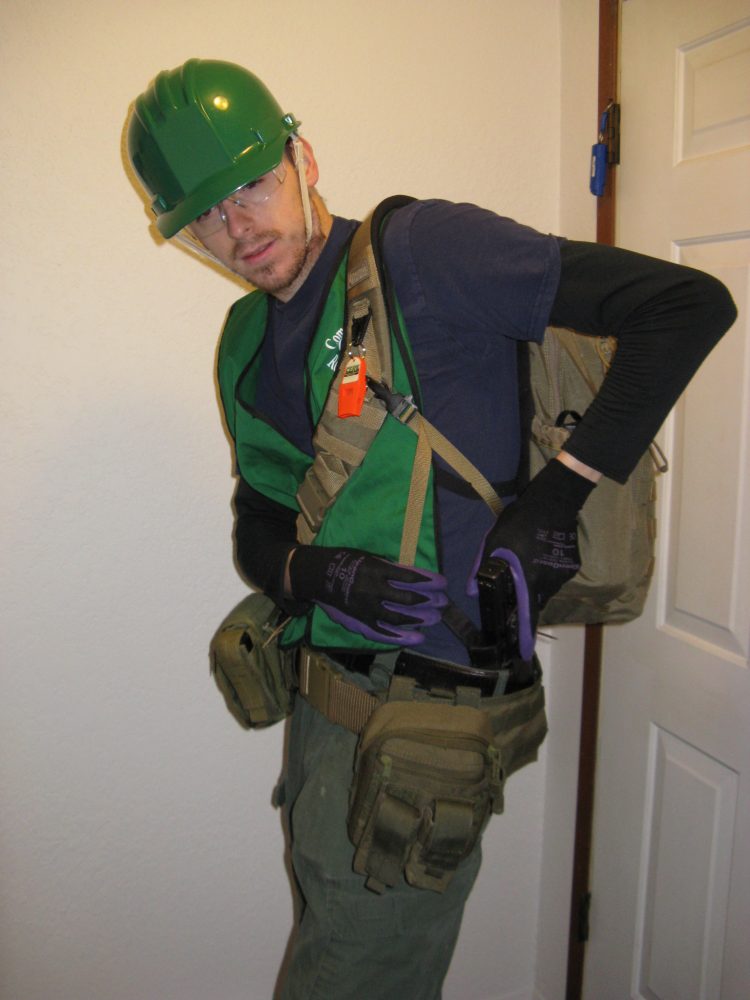
UNIT 6: DISASTER PSYCHOLOGY AND CERT ORGANIZATION
Before class, I had the opportunity to ask Bob about an issue that I’m sure S.W.A.T. readers are very concerned about—how does CERT deal with violence? After all, Hurricanes Katrina and Sandy highlighted the dangers of looters after a disaster, and I wouldn’t want somebody high on meth wandering into my medical station with a baseball bat.
Bob’s answer was “We don’t talk about it.” There are a variety of liability reasons why they don’t discuss the issue with trainees. Bob’s advice was that each CERT member should acknowledge the possibility of encountering miscreants, and prepare themselves in a manner they are comfortable with.
I can understand why they don’t provide specific advice or training, but I would have preferred the program to have an official statement, such as “If you encounter violent people in the field, we aren’t allowed to tell you how to deal with them, but you should develop a contingency plan with your buddy.” During class, Bob briefly touched on the issue, specifically as it pertains to security in your medical station or command post. I was glad he took the time to do this for the other students.
Amy walked us through the psychological phases victims and rescuers go through, and when they’re likely to exhibit those behaviors. She also discussed how rotating CERTs through tasks of different stress levels and scheduling a debriefing can help minimize CERTs suffering from PTSD.
Next was an in-depth lesson on the ICS and how to organize a CERT team, as well as how the chain of command cooperates with other emergency agencies. For example, the CERT team chooses an Incident Commander, who runs the command post, issues instructions to the teams, communicates with other emergency responders, and handles paperwork. At the end of this unit, we had covered all the learning material. The next two weeks were spent implementing what we had learned.
UNIT 7: TABLETOP EXERCISE
We were broken into small groups and worked on the “Roger’s College” tabletop exercise with guest instructor Michael Steed. The purpose was to verbally walk through running a CERT team after an earthquake. We were given maps of a fictional university and town, and periodically updated about how the event was unfolding, prompting us to discuss the issues and find the best way for our team to deal with the situation.
In the exercise, our team was left stranded on the university campus for nearly a week. In addition to stabilizing victims, we had to consider long-term health and sanitation, psychology, supply limitations, and communication issues. Believe me, talking through the material we had learned was a lot harder than it sounds.
UNIT 8: FINAL EXERCISE
Just before our final day of class, most of the gear I had ordered for my CERT kit arrived, including a Gen2 Battle Belt and various equipment pouches, all made by Condor. I’m a very compartmentalized individual, and I was sick of rummaging through my backpack every time I needed something. As a first-time buyer, I found the Condor gear well made and a great supplement to my Maxpedition Gearslinger backpack.
The equipment paid off during our final exercise. Our 13-person class spent two hours extracting 21 volunteer “victims” and a crash dummy from a nearby campus storage warehouse and treating them in a makeshift medical station after a simulated earthquake.
As one of the first people to arrive, I was given the opportunity to be the Incident Commander. I wanted to do it but decided to cede the position to a student who had recently injured her arm. Since Becka and I are able-bodied people, we decided we were better suited to do the heavy lifting.
After ten minutes of planning, the search teams headed out to the warehouse. Becka and I went around the building to make sure nobody was outside, then went in to meet the other teams. Upon stepping through the door, the only word I can use to describe the situation was chaos, with the lights out and 15 or so people in full moulage (injury special-effects makeup) screaming for help.
About half of the search teams experienced sensory overload, with so much going on that they psychologically shut down. After the other teams triaged and tagged the victims, they had no idea what to do next. Teams started moving people from the back of the building instead of the victims blocking the door. We forgot to splint and bandage injuries before moving people. It was insanely overwhelming and took about 45 minutes to get into a rhythm.
After two grueling hours, we finally had all the people out of the building (including the two or three who “died” on-scene after being left for too long). We plodded our way back to the medical station for a wrap-up and debrief. Demoralized by our poor performance, most of us felt terrible. To my surprise, the instructors informed us that we’d actually done well! Apparently, crash-and-burn during the final exercise is inevitable.
FINAL THOUGHTS
Overall, I was amazed at how comprehensive the course was. Even though we can opt out of being active CERT members, Becka and I plan to remain active and take further training to become CERT instructors.
Bottom line: This class will teach you much more than you’d expect from a Federal agency, and you can use the knowledge to dig your neighborhood (or at least your family) out after a major disaster.
